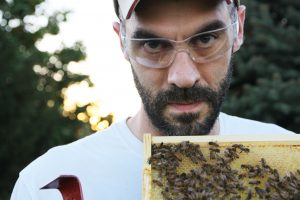
Hello! This is Kacey from Two Million Blooms, and I’m honored to be guest blogging for The Land Connection today!Since graduating from the Central Illinois Farm Beginnings (CIFB) program, a lot has happened! Here’s the skinny.
- Added 30 additional treatment-free hives
- Worked closely with a mentor
- Established a second apiary
- Harvested bucketloads of delicious, raw honey
- Became a vendor at the Champaign Farmers’ Market and hired a baker (my wife works cheap!)
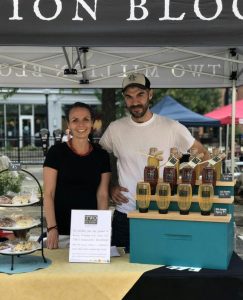 That last point is one we’re particularly excited about and marked a significant milestone for us.After getting our feet wet in a “collective” tent last season, we decided this was the year to establish our own presence. We determined to make it a family affair…aside from raw honey and some herbs, my wife would make her delicious, fresh-baked scones and cookies. As parents, we plan to use the venue as a way to cultivate the budding entrepreneurial spirit of our young girls. (Watch for the addition of honey sticks and beeswax products in the near future.)
That last point is one we’re particularly excited about and marked a significant milestone for us.After getting our feet wet in a “collective” tent last season, we decided this was the year to establish our own presence. We determined to make it a family affair…aside from raw honey and some herbs, my wife would make her delicious, fresh-baked scones and cookies. As parents, we plan to use the venue as a way to cultivate the budding entrepreneurial spirit of our young girls. (Watch for the addition of honey sticks and beeswax products in the near future.)
Know Your Beekeeper, Know Your Honey
The motto “Know Your Farmer, Know Your Food” would have made little sense 50–100 years ago, when nearly all of our food was grown locally and without synthetic pesticides and fertilizers. Today, we live in an age of factory-farmed foods labeled with scenes of idyllic farm life.
In the same way, the conventional beekeeping/honey industry is propped up by an unsustainable, “treatment treadmill” of in-hive pesticides and artificial feeds. And few people know that 80% of honey consumed in the U.S. is imported, ultra-filtered (to hide the country of origin), and often diluted with cheaper sweeteners such as HFCS.
The best way to know what’s in that bear-shaped bottle? Know your beekeeper.
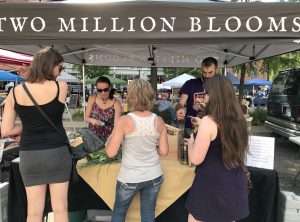 Farmers’ markets usually have at least one honey vendor, and most beekeepers are passionate about their craft, enthusiastic about educating others.For us, this direct engagement with customers’ questions has been refreshing and is one of our favorite aspects of the market. Here are some of the common questions we hear:
Farmers’ markets usually have at least one honey vendor, and most beekeepers are passionate about their craft, enthusiastic about educating others.For us, this direct engagement with customers’ questions has been refreshing and is one of our favorite aspects of the market. Here are some of the common questions we hear:
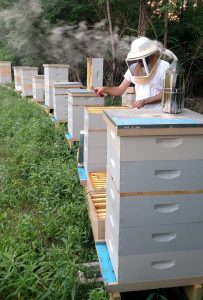
Q: This is local honey? / Where is your farm located?
A: Yes. We have hives in both Champaign and Urbana. We’ve partnered with ecologically-minded landowners who host hives in exchange for “honey rent.”Q: What does “raw honey” mean?
A: Raw honey is unheated and unfiltered, which means it still contains everything the bees put into it. Not heating/filtering also preserves the honey’s delicate flavor and aroma.
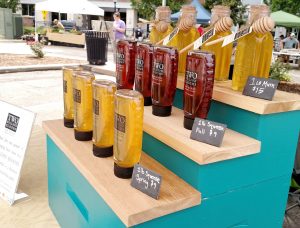
Q: What’s the difference between the two colors?
A: Generally, we harvest twice a year—after spring and in late summer or early fall. The color is mainly influenced by the type of nectars the bees are gathering. Spring blossoms (trees, dandelions, white clover) produce a lighter honey, while nectars collected in summer (asters and goldenrod) result in a darker, amber-colored honey.
Q: Do they taste different?
A: Yes! The color of honey often hits at its flavor. Spring blossoms tend to produce delicate, floral notes, while darker varieties are more rich and robust in flavor.
It’s questions like these (and the ensuing conversations) that we welcome and encourage.
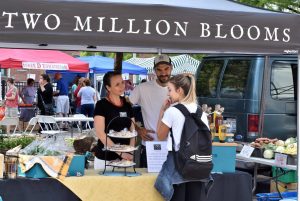 Knowing your farmer makes for a satisfying customer experience, but these interactions are also gratifying to us, because they foster trust and connect people to delicious, ethical and sustainable food.If you have questions about our business or farming practices, come out to the Tuesday market in downtown Champaign. We’d love to meet you!
Knowing your farmer makes for a satisfying customer experience, but these interactions are also gratifying to us, because they foster trust and connect people to delicious, ethical and sustainable food.If you have questions about our business or farming practices, come out to the Tuesday market in downtown Champaign. We’d love to meet you!
There are few questions which are “none of your beeswax.”


